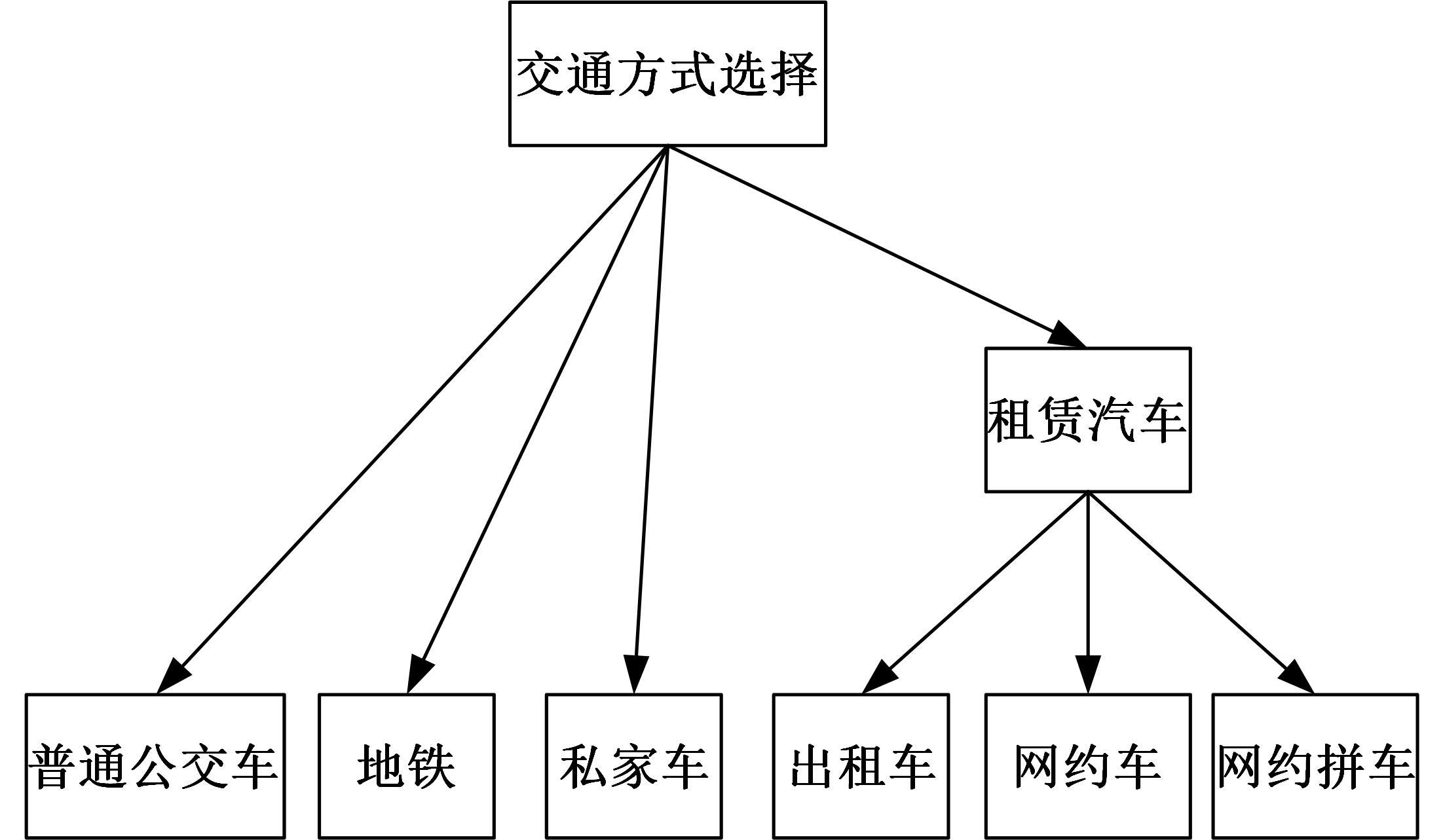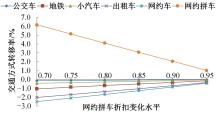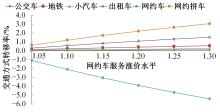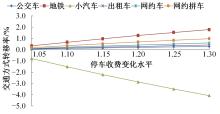Journal of Jilin University(Engineering and Technology Edition) ›› 2022, Vol. 52 ›› Issue (3): 578-584.doi: 10.13229/j.cnki.jdxbgxb20200831
Choice preference analysis and modeling of ridesplitting service
Xing-hua LI1,2( ),Fei-yu FENG1,2,Cheng CHENG1,2(
),Fei-yu FENG1,2,Cheng CHENG1,2( ),Wei WANG1,2,Peng-cheng TANG3
),Wei WANG1,2,Peng-cheng TANG3
- 1.The Key Laboratory of Road and Traffic Engineering,Ministry of Education,Tongji University,Shanghai 201804,China
2.China Transportation Institute at Tongji,Shanghai 200092,China
3.China Roads Communications Science & Technology Group Co. ,Ltd. ,Shijiazhuang 050035,China
CLC Number:
- U121
| 1 | Li W X, Pu Z Y, Li Y, et al. Characterization of ridesplitting based on observed data: a case study of Chengdu, China[J]. Transportation Research Part C: Emerging Technologies, 2019, 100:330-353. |
| 2 | Shaheen S, Cohen A. Shared ride services in North America: definitions, impacts, and the future of pooling[J]. Transport Reviews, 2019, 39(4):427-442. |
| 3 | Chen X Q, Zahiri M, Zhang S C. Understanding ridesplitting behavior of on-demand ride services: An ensemble learning approach[J]. Transportation Research Part C: Emerging Technologies, 2017,76:51-70. |
| 4 | 国家发展改革委. 关于促进绿色消费的指导意见[DB/OL].[2016-03-02]. |
| 5 | Mohamed M J, Rye T, Fonzone A. Operational and policy implications of ridesourcing services: a case of uber in London, UK[J]. Case Studies on Transport Policy, 2019, 7(4):823-836. |
| 6 | Brown A E. Who and where rideshares? rideshare travel and use in los angeles[J]. Transportation Research Part A: Policy and Practice, 2020, 136(6):120-134. |
| 7 | Moody J, Middleton S, Zhao J H. Rider-to-rider discriminatory attitudes and ridesharing behavior[J]. Transportation Research Part F: Traffic Psychology and Behaviour, 2019, 62:258-273. |
| 8 | de Souza Silva L A, de Andrade M O, Maia M L. How does the ride-hailing systems demand affect individual transport regulation?[J]. Research in Transportation Economics, 2018, 69: 600-606. |
| 9 | Dias F F, Lavieri P S, Garikapati V M, et al. A behavioral choice model of the use of car-sharing and ride-sourcing services[J]. Transportation, 2017, 44, 1307-1323. |
| 10 | 方开泰. 均匀设计与均匀设计表[M]. 上海:科学出版社, 1994. |
| 11 | 周伟, 赵胜川. 基于Mixed Logit模型的路线选择行为量化分析[J]. 吉林大学学报:工学版,2013,43(2):304-309. |
| Zhou Wei, Zhao Sheng-Chuan. Quantitative analysis of traveler route choice behavior based on Mixed Logit model[J]. Journal of Jinlin University (Engineering and Technology Edition), 2013, 43(2):304-309. | |
| 12 | 马莹莹,陆思园,张晓明, 等. 考虑个体风险偏好差异的高速公路出行选择模型[J]. 吉林大学学报:工学版,2021,51(5):1673-1683. |
| Ma Ying-ying, Lu Si-yuan, Zhang Xiao-ming, et al. Model of highway travel selection considering individual risk preference difference[J]. Journal of Jinlin University (Engineering and Technology Edition), 2021,51(5):1673-1683. | |
| 13 | 张戎, 李璐, 简文良. 城市货运车辆选择行为模型及应用[J]. 交通运输系统工程与信息, 2018, 18(4):135-141. |
| Zhang Rong, Li Lu, Jian Wen-Liang. Urban freight vehicle type choice model and application[J]. Journal of Transportation Systems Engineering and Information Technology, 2018, 18(4):135-141. |
| [1] | Tian-jun FENG,Xue-lu SUN,Jia-sheng HUANG,Xiu-juan TIAN,Xian-min SONG. Two-phase signal intersection delay based on three crossing modes [J]. Journal of Jilin University(Engineering and Technology Edition), 2022, 52(3): 550-556. |
| [2] | Xian-tong LI,Wei QUAN,Hua WANG,Peng-cheng SUN,Peng-jin AN,Yong-xing MAN. Route travel time prediction on deep learning model through spatiotemporal features [J]. Journal of Jilin University(Engineering and Technology Edition), 2022, 52(3): 557-563. |
| [3] | Hong-fei JIA,Zi-han SHAO,Li-li YANG. Ride⁃sharing matching model and algorithm of online car⁃hailing under condition of uncertain destination [J]. Journal of Jilin University(Engineering and Technology Edition), 2022, 52(3): 564-571. |
| [4] | Yan-feng JIA,Da-yi QU,Lu LIN,Rong-han YAO,Xiao-long MA. Coordinated speed control of connected mixed traffic flow based on trajectory [J]. Journal of Jilin University(Engineering and Technology Edition), 2021, 51(6): 2051-2060. |
| [5] | Ying-ying MA,Si-yuan LU,Xiao-ming ZHANG,Wen-shu WEI. Model of highway travel selection considering individual risk preference difference [J]. Journal of Jilin University(Engineering and Technology Edition), 2021, 51(5): 1673-1683. |
| [6] | Chang-fu ZONG,Long WEN,Lei HE. Object detection based on Euclidean clustering algorithm with 3D laser scanner [J]. Journal of Jilin University(Engineering and Technology Edition), 2020, 50(1): 107-113. |
| [7] | Liang JIANG,Yi HE. Risky driving behavior and influencing factors analysis for electric two⁃wheeler [J]. Journal of Jilin University(Engineering and Technology Edition), 2019, 49(4): 1107-1113. |
| [8] | Xiao⁃qin LUO,Dian⁃hai WANG,Sheng JIN. Traffic signal actuated control at isolated intersections for heterogeneous traffic [J]. Journal of Jilin University(Engineering and Technology Edition), 2019, 49(3): 695-704. |
| [9] | Zhi⁃hui LI,Tao ZHONG,Yong⁃hua ZHAO,Yong⁃li HU,Hai⁃tao LI,Jing⁃wei ZHAO. Pedestrian tracking algorithm for autonomous driving [J]. Journal of Jilin University(Engineering and Technology Edition), 2019, 49(3): 680-687. |
| [10] | QU Da-yi,YANG Jing-ru,BING Qi-chun,WANG Wu-lin,ZHOU Jing-chun. Arterial traffic offset optimization based on queue characteristics at adjacent intersections [J]. Journal of Jilin University(Engineering and Technology Edition), 2018, 48(6): 1685-1693. |
| [11] | LI Zhi-hui, HU Yong-li, ZHAO Yong-hua, MA Jia-lei, LI Hai-tao, ZHONG Tao, YANG Shao-hui. Locating moving pedestrian from running vehicle [J]. 吉林大学学报(工学版), 2018, 48(3): 694-703. |
| [12] | SUN Zong-yuan, FANG Shou-en. Hierarchical clustering algorithm of moving vehicle trajectories in entrances and exits freeway [J]. 吉林大学学报(工学版), 2017, 47(6): 1696-1702. |
| [13] | ZHANG Zhe, JIA Li-min, QIN Yong, YUN Ting. Equalization-based feedback control model of pedestrian counter flow [J]. 吉林大学学报(工学版), 2017, 47(6): 1728-1737. |
| [14] | SHAO Sai, BI Jun, GUAN Wei. Electric vehicle routing problem with charging and dynamic customer demands [J]. 吉林大学学报(工学版), 2017, 47(6): 1688-1695. |
| [15] | LI Ye, WANG Wei, XING Lu, WANG Hao, DONG Chang-yin. Improving traffic efficiency of highway by integration of adaptive cruise control and variable speed limit control [J]. 吉林大学学报(工学版), 2017, 47(5): 1420-1425. |
|
||







